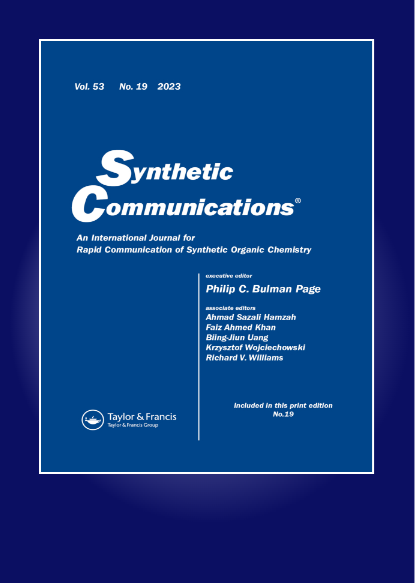新型双-(三氟甲基-5-苯基-1,3,4-恶二唑-2-基)甲基)-1,8-萘啶支架的绿色合成及抗癌评价
IF 1.8
3区 化学
Q3 CHEMISTRY, ORGANIC
引用次数: 0
摘要
微波环境友好型构建了3-(3,5-双(三氟甲基)苯基)-1-((5-苯基-1,3,4-恶二唑-2-基)甲基)-1,8-萘啶-2(1H)- 1衍生物(10a-j),在PhI(OAc)2存在下,在最短的时间内获得了极好的产率和最大的选择性。这条路线符合绿色化学的原则,因为它显著缩短了反应时间,提高了能源效率,简单,高产率。通过IR、1H NMR、13C NMR、质谱和元素分析等方法对合成的化合物进行了表征。合成的化合物对MCF-7、Colo-205、A549和SiHa 4种人宫颈癌细胞株进行了细胞毒性试验;其中化合物10i的IC50值与临床标准药物相比,分别为11.21±0.17 μM (MCF-7乳腺癌细胞系)、11.62±0.54 μM (Colo-205结肠癌细胞系)、17.85±0.48 μM (A549肺癌上皮细胞)、19.64±0.46 μM (SiHa人宫颈癌细胞系),具有较强的抗肿瘤活性。本文章由计算机程序翻译,如有差异,请以英文原文为准。
Green synthesis and anticancer evaluation of novel bis-(trifluoromethyl-5-phenyl-1,3,4-oxadiazol-2-yl) methyl)-1,8-naphthyridine scaffolds
Eco-friendly construction of a 3-(3,5-bis(trifluoromethyl)phenyl)-1-((5-phenyl-1,3,4-oxadiazol-2-yl) methyl)-1,8-naphthyridin-2(1H)-one derivatives (10a–j) under microwave method furnished excellent yields in minimal time with maximum selectivity in the presence of PhI(OAc)2. This route aligns with the principles of green chemistry due to its significantly reduced reaction time and enriched energy efficiency, simplicity, and high yields. The synthesized compounds were characterized by spectroscopic techniques IR,1H NMR,13C NMR, Mass spectrometry, and elemental analysis studies. All the synthesized compounds cytotoxicity was tested against four cancer cell lines, MCF-7, Colo-205, A549, and SiHa human Cervix cancer cell lines; all the compounds demonstrated remarkable in vitro anticancer activity, notably, among them, compound 10i exhibited the most potent anti-cancer activity of IC50 valves are 11.21 ± 0.17 μM (MCF-7 breast cancer cell line), 11.62 ± 0.54 μM (Colo-205 colon cancer cell line), 17.85 ± 0.48 μM (A549 lung carcinoma epithelial cells), 19.64 ± 0.46 μM (SiHa human Cervix cancer cell line) compared with clinical standard drug.
求助全文
通过发布文献求助,成功后即可免费获取论文全文。
去求助
来源期刊

Synthetic Communications
化学-有机化学
CiteScore
4.40
自引率
4.80%
发文量
156
审稿时长
4.3 months
期刊介绍:
Synthetic Communications presents communications describing new methods, reagents, and other synthetic work pertaining to organic chemistry with sufficient experimental detail to permit reported reactions to be repeated by a chemist reasonably skilled in the art. In addition, the Journal features short, focused review articles discussing topics within its remit of synthetic organic chemistry.
 求助内容:
求助内容: 应助结果提醒方式:
应助结果提醒方式:


